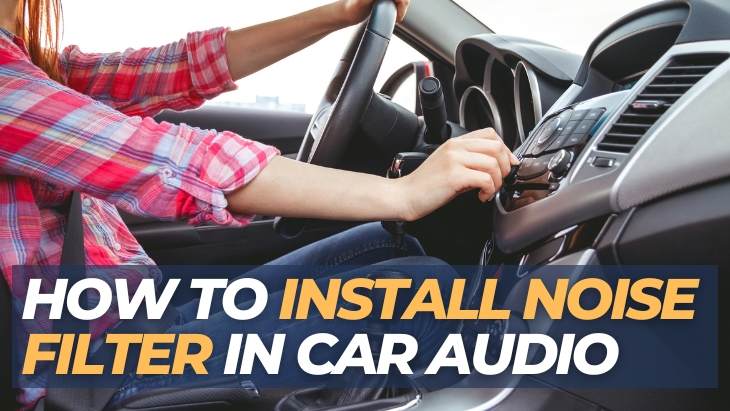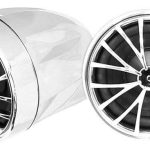Don’t you hate when you’re cruising down the highway jamming to your favorite tunes, but your music sounds all muddled and messy? Or when you’re taking a call but can barely hear the person over the road noise? All those engine rumbles, tire sounds and wind from open windows can ruin your car audio experience. Installing a noise filter for your car stereo is a great way to get cleaner, better sound while driving. This handy guide will walk through everything you need to know about how to install noise filter car audio so you can start enjoying your rides with less noise and interruption.
The Lowdown on Car Audio Noise Filters
So what exactly is a noise filter for car audio anyway? It’s a device that reduces or removes certain frequencies while letting the rest of the audio continue through your car speakers. By blocking out specific ranges of sound, it helps minimize disruptive noises coming from your engine, exhaust, tires, wind, and all those other sources.
Your car’s noise filter acts like a bouncer at an exclusive club, letting the good sounds through while keeping out the bad. This results in lower ambient noise, so you just hear the sweet sounds of your stereo – not a bunch of unwanted noises.
Why Add a Noise Filter to Your Ride?
Adding an audio noise filter can make a huge difference in sound quality while driving. Here are some of the benefits you can expect:
- Music will sound crisper and clearer at any volume
- The more detailed, dynamic sound across the frequency spectrum
- Phone calls and podcasts are easier to understand
- Don’t need to crank the volume to overcome road noise
- Speakers protected from potential damage due to engine vibration
- Overall premium listening experience in your vehicle
Whether you’re all about bass-thumping hip hop or crystal clear classical, a quality noise filter helps every genre of music shine. It’s absolutely worth installing one if you want to improve your in-car audio system.
Picking out the Right Noise Filter
There are a few different types of car audio noise filters out there. Choosing the right match for your system and budget is key to getting optimal results.
1. Passive Noise Filters
These are analog units that sit between your head unit (stereo) and the amplifier. They use basic components like capacitors, inductors, and resistors to filter out unwanted frequencies. Passive filters are affordable and simple to install but offer fewer noise reduction capabilities compared to other options.
2. Powered Noise Filters
These have a built-in amplifier that not only filters noise but also amplifies the audio signal. This provides lowered noise along with boosted clarity and volume. Powered filters give better performance but cost more than passive ones.
3. DSP Noise Filters
DSP stands for digital sound processing. These filters use advanced digital tech and algorithms to analyze incoming audio and alter the outgoing sound. DSP noise filters actively reduce ambient noise in real time for the cleanest signal. They deliver the most dramatic reduction but also come at the highest price.
To find the right match, think about your budget, existing stereo equipment, and the noise sources you want to reduce. Going for the most advanced filter you can afford will yield the best experience.
Gearing Up to Install Car Audio Noise Filter
All right, you’ve got your new noise filter. Now it’s time for the fun part – installing it! This will require some common car audio tools and supplies:
- Noise filter device
- Wiring – power cables, ground wires, RCA cables, speaker wire
- Electrical tape, zip ties, crimp connectors
- Wire stripper and crimper
- Torx bits and trim removal tools
- Multimeter to test connections
- Assorted screwdrivers, wrenches, socket set, drill
Having all the gear ready ahead of time will make this a smooth install. Check your noise filter’s manual to see if you need any special brackets, hardware, or wiring.
Setting the Stage with Pre-Installation Steps
To prep for putting in your car audio noise filter, knock out these tasks first:
- Read the installation guide so you understand how to install and integrate it.
- Disconnect the negative terminal on your battery before wiring anything. Safety first!
- Figure out the optimal location to mount the filter. Under seats or in the dash work well.
- Remove any interior trim panels and carpeting where you’ll run the wiring.
- Have the power and ground wires on hand, sized appropriately for the filter’s requirements.
- For passive filters, get new RCA cables to go between the head unit and amp.
A little bit of planning and setup makes the installation process infinitely smoother. Now let’s get to the wiring.
Step-By-Step How to Install Noise Filter Car Audio
Once you’ve completed the pre-installation steps above, you’re ready to wire in your noise filter. Follow these steps:
1. Mount the noise filter unit
- Secure it under a seat or in the dash using screws through mounting holes or a strong adhesive.
- The location should be clean and away from moisture or heat sources.
2. Connect the ground wire
Run an appropriate gauge ground wire from the negative battery terminal to the ground connection on the filter.
3. Connect power wiring
- Add a fuse-protected power wire from the positive battery terminal to the power input on the filter.
- Use heat shrink butt connectors and electrical tape for solid, covered connections.
4. Install RCA cables
- Run new RCA cords from your stereo’s output to the filter’s input jacks.
- Connect a second RCA cable between the filter’s output and your amplifier’s input.
5. Adjust filter settings
Power up the stereo and filter and make changes to crossovers, equalizers, and other settings as needed.
6. Connect the amplifier and speakers
With the amp wired up, connect speaker wires from its output to the speakers, maintaining proper impedance.
7. Replace trim panels and test the system
- Carefully reinstall any panels, carpeting, or trim pieces removed during installation.
- Power on your stereo and play music to confirm proper functioning.
Following these car audio noise filter installation steps carefully results in a system that effectively minimizes unwanted noise for a premium listening experience.
Tuning Tips for
Once the physical installation is complete, spend some time tuning your car audio noise filter for ideal performance:
- Play familiar tracks to assess sound quality improvement with the filter installed.
- Start with moderate filter settings, then increase incrementally as needed to reduce noise.
- Test calls and radio tuning to check for clarity; adjust filters to prevent muddiness.
- Consider sound-damping materials in the doors or under the carpet to further reduce road noise.
- Re-adjust settings if speakers are changed or repositioned in the vehicle.
It takes some trial and error to find the perfect tuning that removes disruptive engine and road noise without sacrificing sound quality. But nailing the right settings makes a huge difference in music enjoyment during everyday drives.
Troubleshooting Common Car Audio Noise Filter Issues
Noise filters are reliable, but problems can pop up requiring attention:
- No sound output – Check wiring connections, fuses, head unit function, and gain settings.
- Engine noise not reduced – Ensure ground wire has good chassis contact, clean wire ends, and tighten connectors.
- Alternator whine – Add a capacitor to the filter’s power wire to suppress electrical noise.
- Poor filtration – Completely reset filter settings and increase gradually until optimal noise reduction.
By methodically inspecting your wiring connections and components, you can isolate and fix most car audio noise filter issues.
Conclusion
Adding a quality noise filter specially designed for car audio systems provides cleaner, noise-free music for more enjoyable drives. We’ve covered the benefits of noise filters, product options, how to install noise filter car audio, and usage tips. By taking the time to properly install and tune your filter, you can finally hear all the details in your music without cranking up the volume to drown out unwanted noise. Just don’t get so lost in your favorite playlists that you miss your next exit!
Michael Evanchuk is a San Francisco-based sound engineer with 20 years’ experience installing, troubleshooting, and repairing commercial, automotive, and household sound equipment. Evanchuk owns an auto stereo center, where he offers highly competitive car audio installation and repair services. He has written dozens of articles on different sound engineering topics, all of which have been published in leading journals, blogs, and websites.





